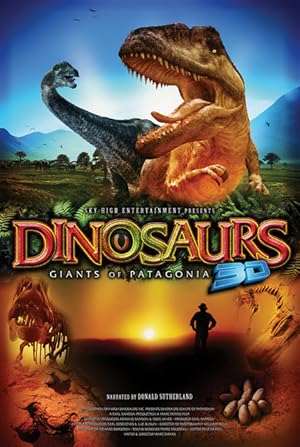
Dinosaurs: Giants of Patagonia Page #2
is important,
no matter how big or small.
The journey to discovery
as the discovery itself.
And sometimes he says
is simply not in our hands.
I like to think that
I am lucky, just incredibly lucky.
Lucky to work in Patagonia,
and lucky to have been there at the
right time with the right knowledge.
Many paleontological discoveries
are not made by professionals.
That's what happened
with the Argentinosaurus,
and it happened again
with yet another dinosaur.
smart colleague and friend of mine.
He and I were notified of the presence
of fossil bones not far from my museum.
We organized a field expedition and
started to dig up more bones.
They were relatively big,
so at first, we thought
that they belonged to a herbivore,
because in general these
dinosaurs tend to be larger.
But instead, the bones
proved to be those of a predator;
a very large one.
Professor Coria's team
had unveiled a first species of
a group of fierce
predators called Giganotosaurus.
The first Giganotosaurus
appeared 100 million years ago.
The 3 species in this group surpassed
the famous T. Rex in terms of size.
Although rare for reptiles,
caring for the young has be observed
among crocodiles for instance.
In dinosaurs, this caring behaviour
evolve enough to remind us of birds.
This baby female is
named Long Tooth.
However small and vulnerable,
and cute she may appear now
she is genetically programmed to
rapidly become a 45 foot long,
eight tonne predator like her mother.
In Patagonia, you have the largest
herbivore and the largest predator,
living at roughly the same
period and in the same territory.
This clearly brings us the question,
Why did this happen
that way in that place?
It is a question,
And as a matter of fact I keep
asking myself the same question.
There is no easy answer.
It could be because
South America, separated from Africa
Evolution followed a
number of particular paths.
However, it's more complex than that.
A dry climate with colder nights
could have favoured animals
that retain their internal heat to better
But a simpler interpretation rest
on a warm climate and the fertile land,
with all the vegetation you can eat.
us that large herbivores
had to grow big enough,
to accommodate a large stomach
required to digest
high in fibre, low in protein vegetation.
Finally, large spans of flat space could
have led naturally to Argentinosaurus,
as the vast seas have led to whales.
Translation
Translate and read this script in other languages:
Select another language:
- - Select -
- 简体中文 (Chinese - Simplified)
- 繁體中文 (Chinese - Traditional)
- Español (Spanish)
- Esperanto (Esperanto)
- 日本語 (Japanese)
- Português (Portuguese)
- Deutsch (German)
- العربية (Arabic)
- Français (French)
- Русский (Russian)
- ಕನ್ನಡ (Kannada)
- 한국어 (Korean)
- עברית (Hebrew)
- Gaeilge (Irish)
- Українська (Ukrainian)
- اردو (Urdu)
- Magyar (Hungarian)
- मानक हिन्दी (Hindi)
- Indonesia (Indonesian)
- Italiano (Italian)
- தமிழ் (Tamil)
- Türkçe (Turkish)
- తెలుగు (Telugu)
- ภาษาไทย (Thai)
- Tiếng Việt (Vietnamese)
- Čeština (Czech)
- Polski (Polish)
- Bahasa Indonesia (Indonesian)
- Românește (Romanian)
- Nederlands (Dutch)
- Ελληνικά (Greek)
- Latinum (Latin)
- Svenska (Swedish)
- Dansk (Danish)
- Suomi (Finnish)
- فارسی (Persian)
- ייִדיש (Yiddish)
- հայերեն (Armenian)
- Norsk (Norwegian)
- English (English)
Citation
Use the citation below to add this screenplay to your bibliography:
Style:MLAChicagoAPA
"Dinosaurs: Giants of Patagonia" Scripts.com. STANDS4 LLC, 2024. Web. 26 Apr. 2024. <https://www.scripts.com/script/dinosaurs:_giants_of_patagonia_6942>.


Discuss this script with the community:
Report Comment
We're doing our best to make sure our content is useful, accurate and safe.
If by any chance you spot an inappropriate comment while navigating through our website please use this form to let us know, and we'll take care of it shortly.
Attachment
You need to be logged in to favorite.
Log In